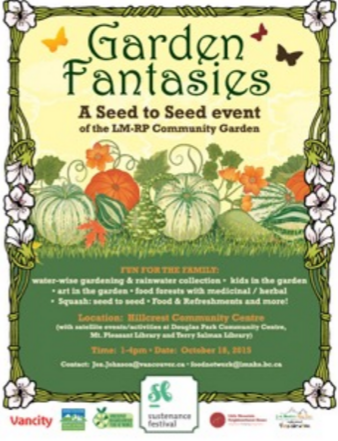
Hello and welcome back to our blog! We are excited to share with you the progression we have made in our community project since our last posting. Since out last blog posting, our main objectives for the project, outlined in our last post, have shifted due to a few key developments that we have had. With the help of the Rolfe et al.’s framework, we will critically reflect on a significant breakthrough that helped us redefine our objectives and give us a new understanding of our project.
What?
The two original objectives described in our last posting were to define a mini food hub model for Little Mountain Riley Park as well as to create an operations manual that would be used by the LM-RH Neighborhood Food Network to govern and manage the new community garden. The first part of our breakthrough was our meeting at Hillcrest Recreation Centre. On September 22nd, our group met with our community partner, Joanne McKinnon (the coordinator of LM-RP Food Network), to discuss our project and get a better understanding of our objectives. Unfortunately, we left the meeting feeling more confused than when we entered, due to the fact that the meeting mainly covered the planning and organization of the upcoming LM-RP Sustenance Festival and we only briefly touched on the aim of our community project. This obviously left our group feeling disheartened, muddled, and stuck; we knew we couldn’t move forward until we had a much clearer understanding of our objectives.
The second component of our breakthrough was the feedback we received after presenting our project proposal to the class. After presenting the same two objectives we had formed at the initiation of our project, we received a very eye-opening response from our audience. It was suggested to us that not only one, but both of our objectives were beyond the scope of our project and that it would be in our, as well as our community stakeholder’s, best interest to simplify and remodel our aim.
These significant moments in the morphology of our project have taught us valuable lessons that we can bring forward to make our project more successful.
So What?
The experiences described above tell us that as a team, we are very focused on adhering to guidelines and rubrics that are set out for us and there exists among us a level of uncertainty around stepping outside of these guidelines and remodeling the scope of our work. Our decision to keep our original objectives in our project proposal despite lacking a true understanding of their scope was based on our fear of straying from our project description given to us by LFS 350. Similarly, our failure to see significance in the meeting with our community partner shows that we are too focused on exploring the exact objectives laid out in the project description to appreciate the opportunities that are provided to us in these meetings.
Much like Chef Dan Barber’s relentless attempts to produce ethically raised foie gras in New York, we must pause and consider whether components of our project are within the scope of our abilities and resources. Although Barber is still continuing his journey to successfully raise “wild geese,” on his farm in New York, he realizes that there may be no humanly possible way to do it with the climate and predation that he is working with. Being aware of and honest about the limitations in any given project will benefit everyone involved and create a more efficient and successful project.
Additionally, Sisonke Msimang points out in her podcast that it is critical to listen to the people that you are working with in more ways than one. We must listen “not just to the words…but to the silences,” are words that parallel very well with our struggle to form a connection and understand what our community partner wanted from us during our first meeting on September 22nd. Because our group was so focused on delivering what our project description outlined for us, we failed to understand the importance of community engagement and the huge role that the Sustenance Festival would play in our mission to create an operations manual.
Now What?
Moving forward, our group is now comfortable with the idea that some aspects of our project may be beyond the scope of our mission and that we need to be flexible in order to make this project successful. At the end of the day, having a small deliverable that is actually helpful to our community partner is much more valuable than “biting off more than we can chew” and ending up with a deliverable that sticks to our original objectives but is not useful to the community.
Additionally, we now appreciate that all occasions to engage with our community members and partners are opportunities for us to gain valuable knowledge that will ultimately make our project stronger and more successful. Community-based project development must be a process in which all members have a chance to be heard, and all opinions and components are valuable parts of a collective project.
Our upcoming objectives are to further engage with the community members of LM-RP in order to better understand what they want to see in a community garden. We will be doing this by attending the Sustenance Festival on October 18th and asking community members to complete a survey they we have put together. In addition, we will be collecting information on recommended operations manual outlines by referencing successful community gardens from all over North America.
This should keep us busy until our next posting, thanks for reading!
-Group 10
References
Glass, Ira. (2011). Poultry Slam 2011: Act 3: Latin Liver. This American Life Podcast. Podcast retrieved from http://www.thisamericanlife.org/radio-archives/episode/452/poultry-slam-2011
Msimang, S. (2014, Dec, 10). A Pragmatic Idealist. The Moth Podcast. Podcast retrieved from http://themoth.org/posts/stories/a-pragmatic-idealist
Rolfe, G., Freshwater, D., Jasper, M. (2001) Critical reflection in nursing and the helping professions: a user’s guide. Basingstoke: Palgrave Macmillan.